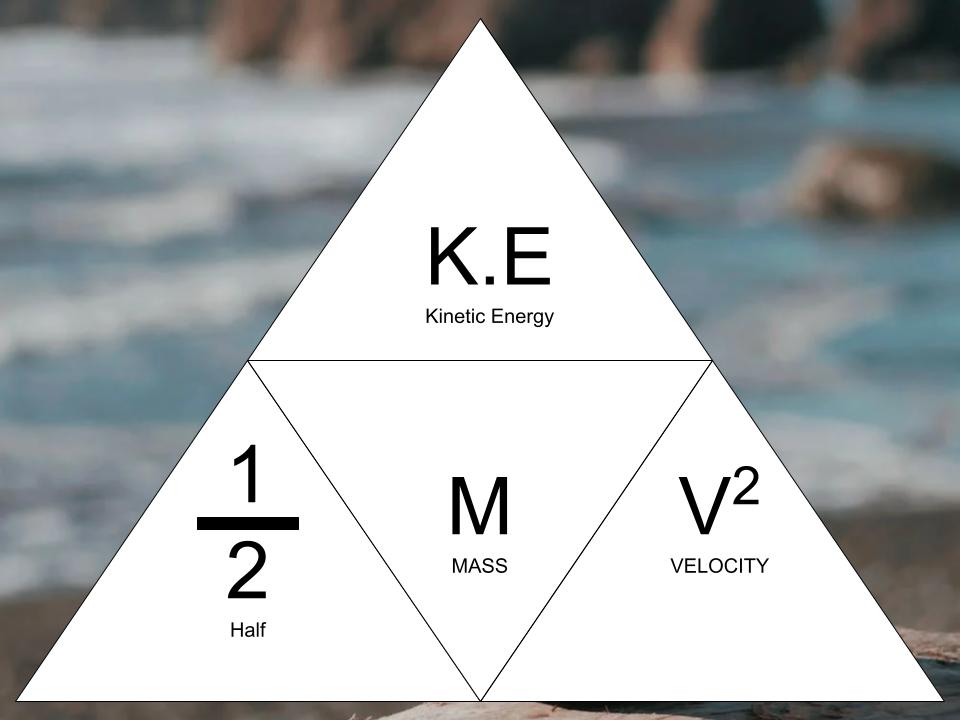This website uses cookies so that we can provide you with the best user experience possible. Cookie information is stored in your browser and performs functions such as recognising you when you return to our website and helping our team to understand which sections of the website you find most interesting and useful.
Kinetic energy
The motion of an object with mass is measured by the kinetic energy equation.
Formula: K.E. = 1/2 m v2
Kinetic Energy Calculator
Mass = Kilograms (kg) and Velocity = Meters per Second (m/s)
Kinetic energy is a consequence of an object's motion, which may have been initiated by a force, however this differs to describing motion energy.
What is meant by Motion Energy?
For example: Let's use a glass of water. Once kinetic energy has stopped being applied to the glass, the glass stops moving. However due to inertia the water retains motion energy, this results in a combination of kinetic and potential exchange of energy until the water stops moving.
Motion Energy is single term which explains kinetic and potential energy exchange. It is an obvious term to adopt for this classical purpose as it describes from a top level that motion is still operating. This would be especially true, if you could not see through the glass and had no idea that the fluid within it was still moving.
Kinetic Electricity
Harvesting kinetic energy to produce electricity has almost exclusively been provided by steam driving an alternating current from a motor. It is this motor method that has been replaced in technology developed by Active Kinetic 1 machines.

Is anything moving kinetic energy?
Yes anything in motion has kinetic energy.
Is it true that a moving object can have no kinetic energy?
Yes, that's correct. Anything in motion has kinetic energy, unless its motion is negligible or at rest relative to its surroundings. Kinetic energy is a property of an object's motion, and it's directly related to its velocity. If an object is stationary or moving at almost the same speed and direction compared to its surroundings, its kinetic energy is considered negligible or practically zero.
For example, if you're sitting in a chair, you have some kinetic energy due to the Earth's rotation, the Earth's orbit around the Sun, and other such motions. However, because these speeds are so vast compared to our everyday experiences, the kinetic energy associated with them is usually considered insignificant for most practical purposes. On the other hand, if an object is moving significantly relative to its surroundings, it will have measurable kinetic energy.
Using kinetic energy.
Pulsatile Kinetic Energy is the most common format for natural sources of kinetic energy. Active Kinetic 1 technology provides a transformational resource to access forms of kinetic energy that have been challenging for traditional electric generating mechanisms that struggle to harness useful amounts of energy. The ocean is a good example where traditional generators don't produce much power.
Kinetic motion technology unlocks the ability to easily and reliably access this kinetic energy and convert it into electricity wherever in the universe we find movement.
What is the equation for kinetic energy?
The mass of an object and it's square velocity is used to calculate Kinetic energy using this equation: K.E. = 1/2 mv2
Translating the physics equation: Kinetic energy = 1/2 (half) Mass x Velocity squared.
More research:
Video explaining Kinetic energy. Part 2 - Energy, Work & Power,
KE or PE - Different types of energy. Potential energy
- AMC – Science
- AI Assistant
- Magnetic Cradle
- About
- Wave Energy
- Vehicles
- Human Energy
- Science
- Demos
- Free Electricity
- Kinetic
- Electricity
- Motion
- CO2
- GHG
- Free Energy
- AI
- IoT
- Marine
- Wind
- Solar
- Renewables
- Batteryless
- Biodiversity
- Bicycle Energy
- Carbon-Free
- LCA
- Contact
- News
- All
- Submit Idea
- Valuation
- Sustainable
- Shares
- Donate
- Login
- Signup

